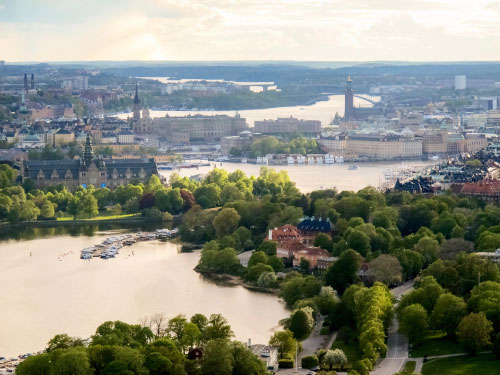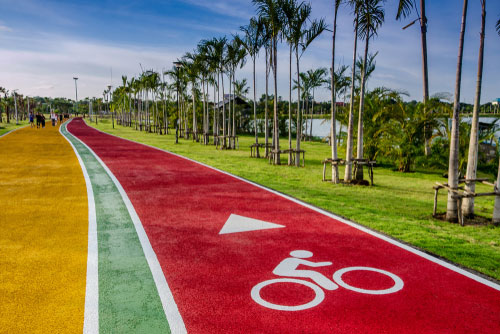What were the world’s greenest cities? What are their environmental strengths and what can we learn from them? Why are cities so important to fight climate change? Let’s figure it out.
A Ranking Of The Most Sustainable Cities In The World
With the goal of understanding the stakes that each city is taking and sharing their best practices, Arcadis, a consulting company focused on managing natural assets, publishes every year a ranking of the 100 most sustainable cities in the world. The goal is to identify which cities are doing a better job – socially, economically and environmentally speaking. These cities are expected to be better prepared to deal with the challenges that urban areas are facing and will further face as our society develops and as climate change events get more frequent and intense.
The ranking of the best cities for the world, also known as the Sustainable Cities Index, is a comprehensive analysis of urban sustainability that analyses cities’ characteristics such as air pollution, the number of metro and bus stops or the percentage of employed people, among other features. In this article, we’ll focus on the environmental side of Arcadis’ study. We’ll present you the world’s greenest and most ecological cities and a summary of what we can learn from them.
- Related content:
Green cities – Which Are The World’s Greenest Cities?
1. Stockholm
2. Frankfurt
3. Zurich
4. Vienna
5. Copenhagen
6. Oslo
7. Hamburg
8. Berlin
9. Munich
10. Montreal
As a result of an averaging process based on 11 main indicators, the ranking of the world’s top green cities, i.e, the ones that are better structured to protect the environment, was found. Using sub-indicators such as the % of green spaces, energy consumption, emissions of CO2, the share of wastewater treated, access to drinking water or governmental incentives for electric vehicles, Arcadia’s study managed to rank the best 100 cities “for” the world.
The world’s most sustainable city, environmentally speaking, is Stockholm. The Swedish capital is followed by Frankfurt, Zurich, Vienna, Copenhagen, Oslo, Hamburg, Berlin, Munich and Montreal, which make the top 10. In a ranking where many Northern European capitals had great results, London was ranked 11th, whereas New York got the 20th position. Paris stayed 25th and Lisbon got the 39th position.
The remaining cities of the ranking top half are located in Europe, Oceania, Brazil and in many coastal cities in the US. As a matter of fact, all U.S. cities consume energy below average, while Chicago, Houston, and Los Angeles have sub-par waste management systems and limited green spaces. On the opposite, in U.S’s most car-friendly cities, the air quality is usually good, although GHG emissions tend to be high.
What Are The Characteristics And Strengths Of Green Cities

The study’s results indicate that the investment in sustainable infrastructures, together with the city’s low CO2 emissions and good air quality, are the main reasons why Stockholm leads the green ranking. As for the top 10 cities, the number of green spaces, the investments made in cycling infrastructures, the air pollution rates below average and the effective waste management systems seem to be the distinguishing characteristics that allow these cities to score well.
The bottom-ranked cities are mostly located in Asia and Africa, like Hanoi (100th), Jakarta (96th) or Cairo (98th). They tend to face challenges related to poor waste management systems, high levels of pollution or limited green spaces. Altogether, these 3 indicators weight 35% for the ranking’s final score, leaving cities that didn’t score well away from the top positions. Arcadia analysts defend that as long as basic needs such as drinking water or waste management aren’t solved, it’ll be hard for these cities to score better, as the investments in low carbon technologies, bicycles lanes, and other important indicators won’t be a priority.
Arcadia’s results also point out that although they got well ranked, some of the top 10 cities score below average on their natural disaster monitoring technologies, despite the fact that some, like Munich, face the real risk of natural catastrophes like floods. On the opposite, Canadian cities Calgary and Otawwa, that have low-risk profiles, have highly developed warning technologies and they are an example concerning security and longterm quality of life.
Green Cities – What Can We Learn From Them?

As the world continues to urbanize it will be challenging to keep and to build sustainable cities. Despite all the warnings, a recent study from C40 pointed out that all together, the world’s cities emit around 70% of the world’s carbon dioxide – considering food, clothing, electronics, air travel and construction materials that are consumed by residents but produced outside city limits. At the same time, the highest concentration of fine particles and air pollution is also found in cities – leading to environmental problems and serious health problems. Waste management is also an issue for cities, as the 27 world megacities (cities with >10 million residents) produce 12% of the global waste which endangers public health and the balance of the surrounding ecosystems as well.
To solve both the problems mentioned above and others to come, it’s important to bear in mind which are the greenest and most ecological cities, learn from their best practices and perhaps start re-structuring from there. Having more green spaces and lower air pollution levels, betting on creating cleaner transportation methods and good rates of solid waste management are some of the pillars of green cities. This is certainly a progressive work and there is no universal recipe because each city has its own uniqueness – such as the weather, culture, economic power, innovation strategies (or lack of them) and ways to deal with troubles. And despite the solutions not being black and white, green is definitely the way.
- Related:
Images credits: bike lanes on Shutterstock, sustainable cities on Shutterstock, green cities on Shutterstock, transforming cities on Shutterstock and Stockholm city on Shutterstock

